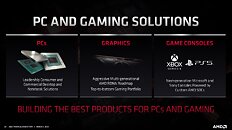- Joined
- Oct 9, 2007
- Messages
- 47,511 (7.49/day)
- Location
- Hyderabad, India
| System Name | RBMK-1000 |
|---|---|
| Processor | AMD Ryzen 7 5700G |
| Motherboard | ASUS ROG Strix B450-E Gaming |
| Cooling | DeepCool Gammax L240 V2 |
| Memory | 2x 8GB G.Skill Sniper X |
| Video Card(s) | Palit GeForce RTX 2080 SUPER GameRock |
| Storage | Western Digital Black NVMe 512GB |
| Display(s) | BenQ 1440p 60 Hz 27-inch |
| Case | Corsair Carbide 100R |
| Audio Device(s) | ASUS SupremeFX S1220A |
| Power Supply | Cooler Master MWE Gold 650W |
| Mouse | ASUS ROG Strix Impact |
| Keyboard | Gamdias Hermes E2 |
| Software | Windows 11 Pro |
At AMD CEO Dr Lisa Su's keynote address at the company's 2020 Financial Analyst Day, a curious slide element caught our eye - a never before seen graphics card design that bears AMD insignia. This is quite possibly AMD's upcoming reference design. The design fits into the language of sharp dark ridges and red accents the company adopted first with its Radeon RX 5700 XT MBA (made by AMD) graphics card, and the hypothetical RX 5600 XT reference design that never made it to the market as the SKU was a partner-exclusive.
In Reddit AMAs following the RX 5700 series launch, corporate vice-president and manager for Radeon, Scott Herkelman, mentioned that all subsequent Radeon RX products by the company would ditch the lateral-blower design in favor of an axial multi-fan design that's characteristic of most partner-designed cards. NVIDIA made that switch with its RTX 20-series Founders Edition cards, and AMD too implemented a triple axial fan design for its Radeon VII card, before switching back to a conventional lateral-blower design for its RX 5700 series. AMD would go on to give the reference design RX 5600 XT an axial dual-fan cooler.



The card in AMD's presentation, however, is unlike anything we've seen so far. From the top three-quarters angle it's been taken, we can confirm two axial fans, a large vent along the entire top of the board that serves as a vent for the heatsink, and an aluminium fin stack that's arranged perpendicular to the plane of the motherboard, rather than parallel to it (i.e., hot air is guided out from the top of the card). Such a fin arrangement has more surface area than fin-stacks in which the fins are arranged along the plane of the motherboard (i.e. hot air is guided from the rear and front ends of the card), for the simple reason that you would end up with more fin-density, if the card is sufficiently long. A hexagonal insert along the top edge has the AMD logo embellishment, while another cutout is where the card's power connectors are located. This "picture" could very well be just a render for now, still on the drawing board, and only an upcoming product months away from launch could be using this design.
View at TechPowerUp Main Site
In Reddit AMAs following the RX 5700 series launch, corporate vice-president and manager for Radeon, Scott Herkelman, mentioned that all subsequent Radeon RX products by the company would ditch the lateral-blower design in favor of an axial multi-fan design that's characteristic of most partner-designed cards. NVIDIA made that switch with its RTX 20-series Founders Edition cards, and AMD too implemented a triple axial fan design for its Radeon VII card, before switching back to a conventional lateral-blower design for its RX 5700 series. AMD would go on to give the reference design RX 5600 XT an axial dual-fan cooler.



The card in AMD's presentation, however, is unlike anything we've seen so far. From the top three-quarters angle it's been taken, we can confirm two axial fans, a large vent along the entire top of the board that serves as a vent for the heatsink, and an aluminium fin stack that's arranged perpendicular to the plane of the motherboard, rather than parallel to it (i.e., hot air is guided out from the top of the card). Such a fin arrangement has more surface area than fin-stacks in which the fins are arranged along the plane of the motherboard (i.e. hot air is guided from the rear and front ends of the card), for the simple reason that you would end up with more fin-density, if the card is sufficiently long. A hexagonal insert along the top edge has the AMD logo embellishment, while another cutout is where the card's power connectors are located. This "picture" could very well be just a render for now, still on the drawing board, and only an upcoming product months away from launch could be using this design.
View at TechPowerUp Main Site





